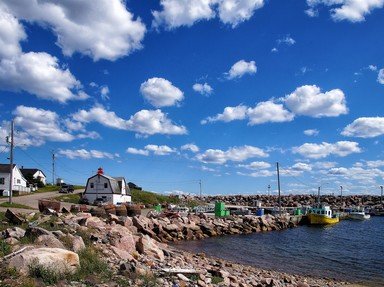Quiz Answer Key and Fun Facts
1. Disembarking from the Newfoundland Ferry, it is a short drive south-east to the Fortress of Louisbourg National Historic Site. Established by the French in 1713 following the Treaty of Utrecht, Fort Louisbourg was completed just in time to defend against a siege in 1745 by which competing colonial nation?
2. After a lovely afternoon visiting Louisbourg, it's back to Sydney for dinner before continuing on our tour of Cape Breton Island. On the Esplanade along the waterfront is where 'The Big Fiddle' can be found. This 18.2 m (60 feet) tall violin is made of spruce and maple, just like its smaller string family counterparts.
3. Cape Breton Highlands National Park is known for its stunning landscapes, and the highway leading to it is just 106 km from Sydney. Sharing its name with a famous explorer, what is this highway called, that circumnavigates the park?
4. After completing the Trail loop, it is a short side trip to the village of Baddeck, where we can find a museum (and National Historic Site) that celebrates the life of a scientist and engineer best known for inventing the telephone. What is his name?
5. Continuing our exploration of Nova Scotia, we connect with the Trans-Canada Highway and pass by Antigonish and Truro on the way to the provincial capital, Halifax. It was here at the Port of Halifax that nearly one million immigrants arrived in Canada between 1928 and 1971. Now, the Canadian Museum of Immigration honours that legacy. Where can it be found?
6. A short trip from the port brings us to the Halifax Citadel, a star-shaped fortress overlooking Halifax Harbour. Since the city's founding in 1749, in which wars has the Citadel been involved in military combat actions?
7. Another historic site that can be found in Halifax is one of the oldest breweries in the country. What Scottish import founded his company here in 1820?
8. After a good night's rest, it's back on the road, following Highway 333 southwest for the short trip to the picturesque village of Peggy's Cove and its iconic lighthouse. The lighthouse (and cove) sit at the entrance to what, appropriately named bay?
9. After having brunch at a lovely seaside cafe, our tour continues just 100 km away and further down the coast in the town of Lunenburg, where the colourful 'Old Town of Lunenburg' was declared a UNESCO World Heritage Site. It also happens to be the home of what famous racing schooner?
10. While a more direct route is possible, our trip continues around the southern end of the peninsula and back north along the Bay of Fundy, eventually bringing us to the Chignecto Isthmus, which connects the province to the rest of Canada. Here, we find another UNESCO World Heritage site: the Joggins Fossil Cliffs, which reveal fossils from what geological period known for the formation of coal deposits?
Source: Author
reedy
This quiz was reviewed by FunTrivia editor
agony before going online.
Any errors found in FunTrivia content are routinely corrected through our feedback system.
